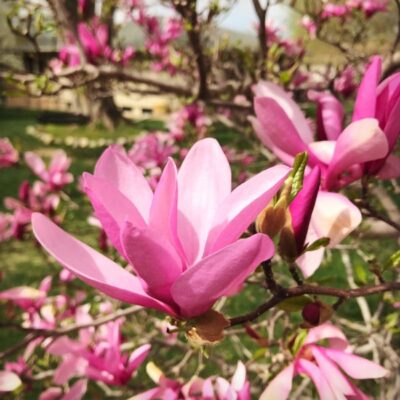Garden Plant: Betty Magnolia
Product Description: Betty Magnolia

Big Fragrant Flowers Sweet Little Betty Magnolia
- Blooms Later Than Other Varieties
- More Reliable Flower Show Even in Frosty Climates
- White and Purple Cup Shaped Flowers
- Heavenly Scent
- Shrubby Habit Great for Flowering Privacy Screen
- Lush Summer Foliage
- Perfect for Smaller Gardens
People love Magnolia trees for their gorgeous blooms and heavenly scent. However, some varieties can get quite large. If you want to grow a smaller, more compact variety that still knocks your socks off with outstanding spring flowers, you will be thrilled to meet Betty Magnolia (Magnolia x \’Betty’).
Betty was developed at the National Arboretum in the 1950\’s as part of the Little Girl Series of hybrid Magnolias. These small, shrubby trees were cunning little crosses between Lily Magnolia (Magnolia liliiflora Nigra’) and Star Magnolia (Magnolia stellata). Betty has a useful, petite size and frost-resistant flower power.
She may be small, but Betty still packs a punch with her full-sized blooms. The red-purple flowers showcase a rich, deep color on the outside and feature pure white interiors. This annual floral display is an incredible welcome to the new growing season.
A wonderful, compact, size for modern lots, Betty is covered with sweet pointed buds from top to bottom. The buds swell and bloom in early spring on bare branches, just as the tender new leaves are starting to unfurl.
Betty blooms a few weeks later than other Magnolia varieties. Northern gardeners love this later season, as those yucky old pesky frosts can hurt earlier bloomers. Betty is a more reliable variety for colder climates.
As her cup shaped flowers fully develop into their mature, open form, the new spring foliage emerges with a coppery hue. It will then deepen to a deep forest green for a lush, full summer coat. In fall, the attractive lance shaped leaves turn bronze for another pretty display.
Don’t be surprised to see Betty produce a few flowers sporadically here and there during the summer and fall. Snip off the buds if you catch them early and bring them inside to bloom in a special vase.
There are so many reasons to love Betty Magnolia. She’s a charming addition to even the tightest yards.
How to Use Betty Magnolia in the Landscape
There are many ways to enjoy this pretty, carefree good time gal. Betty makes a wonderful, pretty flowering privacy screen at your property line. What a nice way to extend the height of your hardscaped fencing!
To create a solid screen, where the canopies will grow together, plant your Betties 6 feet apart on center. You’ll measure from the center of one to the center of the next tree.
No one said a hedge has to be stick straight. Try a curving hedge or loose triangular planting. Farmers have planted their windbreaks in a staggered zig-zagging double row for generations to achieve a solid screen faster.
Play around with your design on paper first and have some fun. Why not create special places in your backyard where you can entertain family and friends? Plants can bring your plan to life.
Try a few trees planted close together behind your patio seating to gently screen out the neighbors. Or use Betty in a nice, mixed hedgerow with summer flowering Rose of Sharon, and evergreen Yews and Arborvitae. You’ll create an easy sense of privacy around your pool deck.
Hide the more utilitarian areas of your yard with a few Betties or use longer hedges in a rectangle to create a private Secret Garden. Imagine hosting wonderful dinner parties surrounded by a living green wall. Add an outdoor dining table and chairs, a fun chandelier and two of our Rose trees placed on either side of the entrance to amplify the experience for your guests.
For privacy, keep the lower limbs and allow the foliage to fill in all the way to the ground for the biggest impact. You’ll love the friendly, flowering fence of this tall, informal hedge.
Betty can also become a lovely small specimen tree. Simply remove the lower limbs to raise the canopy and expose the trunk. Try one at the corner of your house to anchor your foundation planting. Plant a single tree in the lawn to frame a small bungalow or cottage.
Add one or more to the sunny side of tall evergreen trees. You’ll soften the look and give Betty a little protection from the worst of the winter winds. Civilize your windbreaks and shelterbelts with these magnificent spring flowering trees.
Pair with other small Magnolia varieties, like Ann, Butterflies and Star Magnolia for a thrilling collection. Plant them in a loose, informal grouping for a wonderful spring display.
Pro Plant Tips for Care
Betty Magnolia tolerates almost any soil, but is best grown in moist, organically rich, acidic, well-drained loam in full sun to part shade. Plant it in a location protected from high winds.
Betty was bred to be smaller than other Magnolias and bloom later than them too. She is less apt to suffer frost damage in spring. However, it’s a good idea to avoid southern exposures close to houses, as the buds may be tricked by the heat and light to open too early in spring.
Please be patient with Betty. It may take her 2 to 3 years to flower as her root systems get established in your soil. Don’t worry, she is worth the wait.


